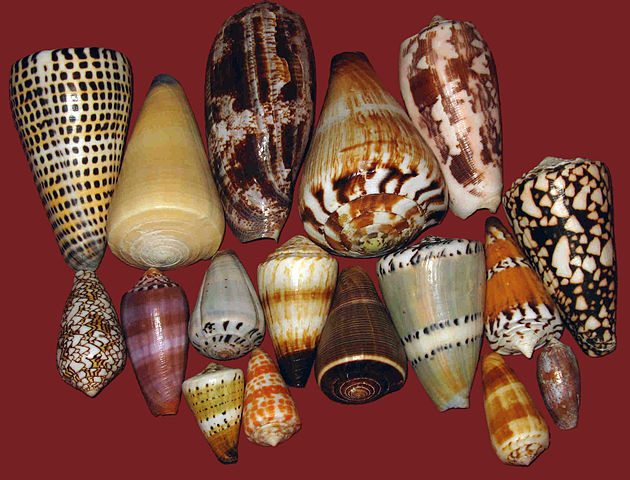in Science

|
What's News in Science 
|
Cone Snails – Danger and Deception Wrapped in Beautiful Packages
by George Shiflet
|
Found in tropical and subtropical oceans, cone snails are predatory molluscs that surround their soft bodies with spiral shells, resembling the cone you might use for ice cream. These shells are generally patterned and colorful, but their beauty masks their danger to unsuspecting prey or to human shell collectors (Figure 1). Some of the most deadly toxins in the world are produced by some species of this group. Of course, the cone snails use the toxins primarily for prey capture, not for killing human beings.

Figure 1. Examples of cone snail shells
Copyright © by Pet at https://commons.wikimedia.org/wiki/File:Sto%C5%BCki2.jpg.
The 750-1000 species of cone snail living today evolved from ancestors that fed primarily on worms, and some still do. Other cone snails prey on other slow-moving molluscs, and certain species have taken to hunting more mobile prey – fish. Preying on faster-moving organisms is a challenge for animals like cone snails, which tend to hide under rocks, within coral reefs, and under the surface of sand.
Fish-Eating Cone Snails: Hunting and Feeding Strategies
Fish-hungry cone snails seem to employ one of three strategies for catching their finned food. The first, and most commonly observed, is sometimes called “taser and tether” by scientists. In these species, the animals extend a tubular proboscis, from beneath their shells. At the end of the tube is a barbed tooth, shaped like the end of a harpoon (Figure 2). The tooth is hollow, and at the right time, venom from modified salivary glands will be pumped in, and the “harpoon” is released, penetrating the flesh of the prey, infusing the tissue with venom. The venom is a complex mixture of many short peptides (short chains of amino acids), many of which act on the nervous system of the prey. The initial effect is to immobilize the fish, but this stage will be followed by complete paralysis. In this way, the snail has also tethered the fish. Then, the cone snail reels in the fish, where an expanded mouth and pharynx engulf the entire fish and begins to digest it. Although the mouth and pharynx can expand greatly, their extent limits the size of the fish the snail can handle successfully. After digestion is completed, the hard parts are regurgitated (Olivera et al. 2015).

Figure 2. Cone snail venom apparatus anatomy. Radular tooth is the specialized harpoon-like tooth produced by these snails. The radular sac contains extra teeth to replace used ones, and the poison gland secretes the venom mix.
Copyright © by Circa24 at https://commons.wikimedia.org/wiki/File:Cone_shell_venom_apparatus.jpg.
Video of cone snail hunt: https://www.youtube.com/watch?v=jYMjLgPFSso
Some cone snails do not tether their prey but search about for a target. Once a fish is detected, the snail quickly deploys its harpoon, injecting its victim, but withdrawing its proboscis rapidly. The prey is disabled but not tethered. The snail patiently tails the victim, waiting for immobilization. Eventually, the snail’s pharynx consumes and digests the fish. This second approach has not been commonly found (Olivera et al. 2015).
Another interesting strategy involves the snail dousing a school of small, sleeping fish with a highly concentrated, chemical cocktail, which narcotize the targets. In this way, the snail can engulf multiple members of the school. Also, it is interesting that the cocktail includes an ingredient that closely resembles insulin, a hormone found in fish and other animals. The insulin is absorbed through a fish’s gill surfaces and into the blood, generating low blood sugar levels that stupefy and de-energize the prey (Olivera et al. 2015).
Human beings sometimes contact cone snails, especially give the attraction of beautiful shells, which may still contain living snails. However, the number of human deaths from such envenomation is often exaggerated. In a recent review of reported injuries from the past 350 years, 141 injuries, including 36 deaths, are recorded (Kohn 2019). Cone snails occur in tropical and subtropical seas throughout the world, and so one would expect some encounters between these snails and human beings. Not all cone snail venoms are as toxic as those described in this article, and if rapid, proper medical care is applied, a painful sting does not have to prove fatal.
Kohn, Alan J. "Conus envenomation of humans: in fact and fiction." Toxins 11, no. 1 (2019): 10.
Olivera, Baldomero M., Jon Seger, Martin P. Horvath, and Alexander E. Fedosov. "Prey-capture strategies of fish-hunting cone snails: behavior, neurobiology and evolution." Brain, behavior and evolution 86, no. 1 (2015): 58-74.